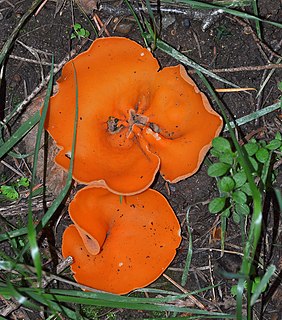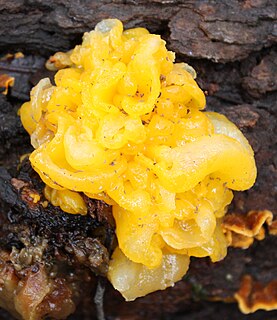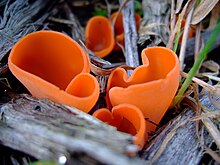
The Pezizaceae are a family of fungi in the Ascomycota which produce mushrooms that tend to grow in the shape of a "cup". Spores are formed on the inner surface of the fruit body (mushroom). The cup shape typically serves to focus raindrops into splashing spores out of the cup. Additionally, the curvature enables wind currents to blow the spores out in a different manner than in most agarics and boletes.

Aleuria aurantia is a widespread ascomycete fungus in the order Pezizales. The brilliant orange, cup-shaped ascocarps often resemble orange peels strewn on the ground, giving this species its common name.
Orange peel is the peel of an orange. Orange Peel or Orange peel may also refer to:

Tremella mesenterica is a common jelly fungus in the family Tremellaceae of the Agaricomycotina. It is most frequently found on dead but attached and on recently fallen branches, especially of angiosperms, as a parasite of wood decay fungi in the genus Peniophora. The gelatinous, orange-yellow fruit body of the fungus, which can grow up to 7.5 cm (3.0 in) diameter, has a convoluted or lobed surface that is greasy or slimy when damp. It grows in crevices in bark, appearing during rainy weather. Within a few days after rain it dries into a thin film or shriveled mass capable of reviving after subsequent rain. This fungus occurs widely in deciduous and mixed forests and is widely distributed in temperate and tropical regions that include Africa, Asia, Australia, Europe, North and South America. Although considered bland and flavorless, the fungus is edible. Tremella mesenterica produces carbohydrates that are attracting research interest because of their various biological activities.

The spider species Argiope aurantia is commonly known as the yellow garden spider, black and yellow garden spider, golden garden spider, writing spider, zigzag spider, zipper spider, black and yellow argiope, corn spider, Steeler spider, or McKinley spider. The species was first described by Hippolyte Lucas in 1833. It is common to the contiguous United States, Hawaii, southern Canada, Mexico, and Central America. It has distinctive yellow and black markings on the abdomen and a mostly white cephalothorax. Its scientific Latin name translates to "gilded silver-face". The body length of males range from 5–9 mm (0.20–0.35 in); females range from 19–28 mm (0.75–1.10 in). These spiders may bite if disturbed or harassed, but the venom is harmless to non-allergic humans, roughly equivalent to a bumblebee sting in intensity.

Banksia aurantia, commonly known as the orange dryandra, is a shrub that is endemic to Western Australia. It has underground stems, deeply divided leaves with 18 to 28 lobes on each sides, about eighty pale orange-pink flowers in each inflorescence, and egg-shaped follicles.

The orange leaf-nosed bat is a bat in the family Hipposideridae. It is the only living species in the genus Rhinonicteris which is endemic to Australia, occurring in the far north and north-west of the continent. They roost in caves, eat moths, and are sensitive to human intrusion.

Rhinonicteris is a genus of leaf-nosed microbats, represented by fossil taxa found at Riverleigh in Queensland and the extant species Rhinonicteris aurantia, which occurs in the north and west of the Australian continent.
†Partula aurantia, common name the Moorean viviparous tree snail, was a species of air-breathing tropical land snail, a terrestrial pulmonate gastropod mollusk in the family Partulidae. This species was endemic to French Polynesia. It is now extinct.

Pseudaleuria is a genus of two species of fungi in the family Pyronemataceae. The genus was circumscribed by Demaris Lusk in 1987 to contain the type, P. quinaultiana, a species found in the Olympic Peninsula of North America. P. fibrillosa was transferred to the genus in 2003.

Antrodia is a genus of fungi in the family Fomitopsidaceae. Antrodia species have fruit bodies that typically resupinate, with the hymenium exposed to the outside; the edges may be turned so as to form narrow brackets. Most species are found in temperate and boreal forests, and cause brown rot.

Caloscypha is a fungal genus in the family Caloscyphaceae. A monotypic genus, it contains the single species Caloscypha fulgens, commonly known as the spring orange peel fungus, the golden cup, or the dazzling cup. It is a cup fungus, typically up to 4 centimetres in diameter, with a bright to pale orange interior and orange; specimens that are old or bruised often have an olive-green discoloration, especially around the edges. In North America, it is usually found on the ground in forest litter near conifers. Fruiting occurs in early spring following snow melt. The asexual (imperfect), or conidial stage of C. fulgens is the plant pathogenic species Geniculodendron pyriforme, known to infect dormant seeds of the Sitka spruce.
Rafflesia aurantia is a member of the genus Rafflesia. It is a parasitic flowering plant endemic to Luzon Island, Philippines in the Quirino Protected Landscape. See original publication and a review of Philippine Rafflesia.

Pellasimnia is a genus of predatory sea snails, marine gastropod mollusk in the subfamily Ovulinae of the family Ovulidae, sometimes known as the false cowries and the cowry allies.

Sarcoscypha dudleyi, commonly known as the crimson cup or the scarlet cup, is a species of fungus in the family Sarcoscyphaceae of the order Pezizales. In addition to its main distribution in the central to eastern United States, the fungus has also been recorded once in Bulgaria. It has been frequently confused with Sarcoscypha coccinea, but can be distinguished from this and other related species in Sarcoscypha by differences in microscopic characteristics, such as the presence and number of oil droplets in the spores. The species Molliardiomyces dudleyi is an imperfect form of the fungus that lacks a sexually reproductive stage in its life cycle.

Strigatella is a genus of sea snails, marine gastropod mollusks in the family Mitridae.

In molecular biology, the fungal fucose-specific lectin family is a family of lectins. Lectins are proteins which are involved in many recognition events at the molecular or cellular level. These fungal lectins, such as Aleuria aurantia lectin AAL, specifically recognise fucosylated glycans. AAL is a dimeric protein, with each monomer being organised into a six-bladed beta-propeller fold and a small antiparallel two-stranded beta-sheet. The beta-propeller fold is important in fucose recognition; five binding pockets are found between the propeller blades. The small beta-sheet, on the other hand, is involved in the dimerisation process.

Rhinonycteridae is a family of bats, allied to the suborder Microchiroptera. The type species, the orange nose-leafed species group Rhinonicteris aurantia, is found across the north of Australia.

Naematelia aurantia is a species of fungus producing yellow, frondose, gelatinous basidiocarps. It is widespread in north temperate regions and is parasitic on another species of fungus that grows on dead attached and recently fallen branches of broadleaf trees. It is commonly called golden ear in North America.














